Critical Analysis of a Healthcare Research Study: Findings and Uses
VerifiedAdded on 2022/08/23
|5
|1052
|24
Homework Assignment
AI Summary
This assignment presents a critical analysis of a healthcare research study, specifically focusing on the efficacy of silicone foam dressings in pressure ulcer treatment. The study, based on a literature review, is identified as non-experimental, with no use of randomness or reflexivity reported. The analysis evaluates the study's trustworthiness and transferability, suggesting potential applications of the findings in clinical practice, such as the use of silicone foam dressings as a prophylactic therapy and in specific patient populations. The analysis highlights the importance of further research, including larger sample sizes and longer study durations, and emphasizes the economic and patient benefits of pressure ulcer prevention through proper skin care and the use of synthetic foam cushions. The analysis references supporting literature and discusses the implications for healthcare professionals seeking to improve patient outcomes and reduce healthcare costs.
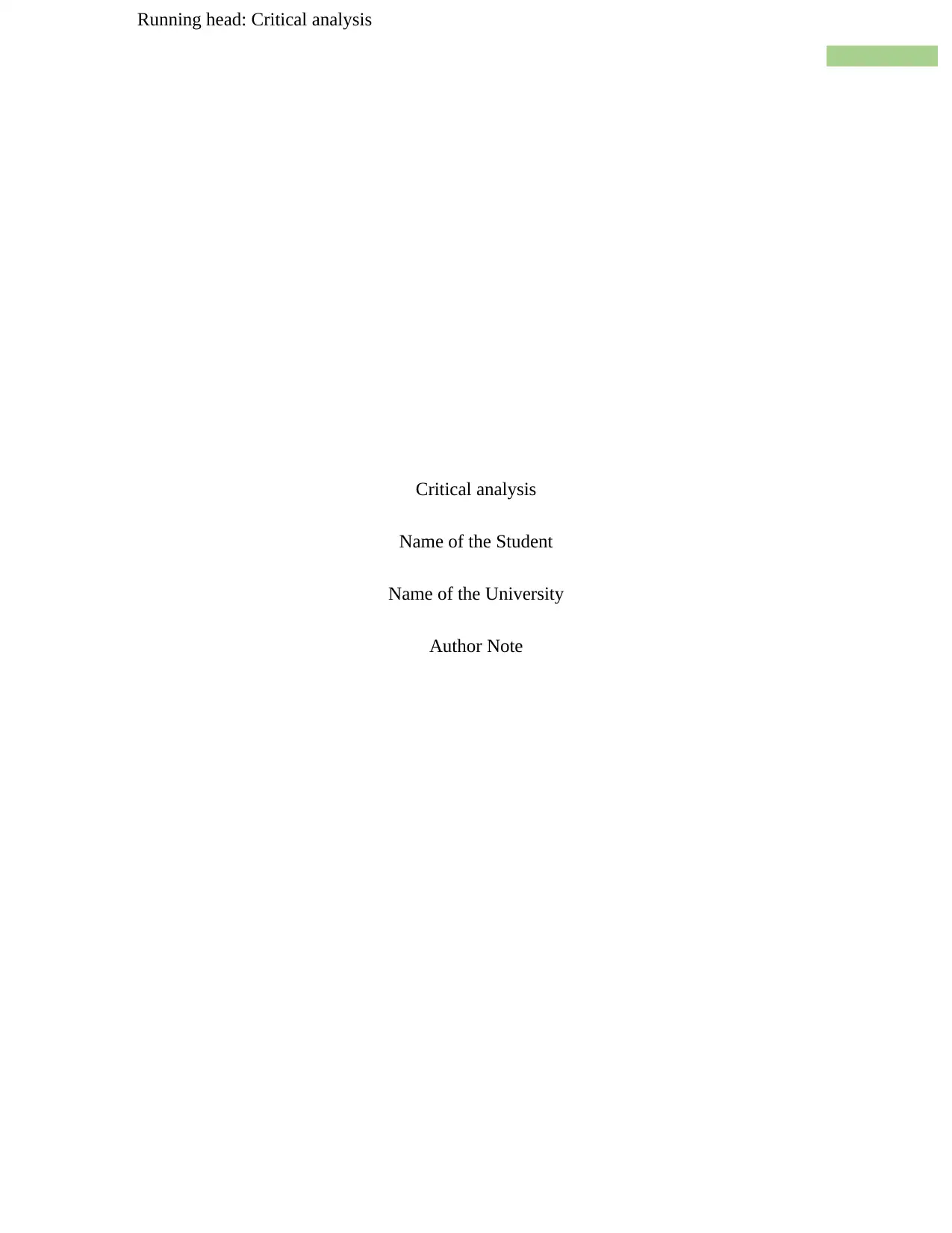
Running head: Critical analysis
Critical analysis
Name of the Student
Name of the University
Author Note
Critical analysis
Name of the Student
Name of the University
Author Note
Paraphrase This Document
Need a fresh take? Get an instant paraphrase of this document with our AI Paraphraser
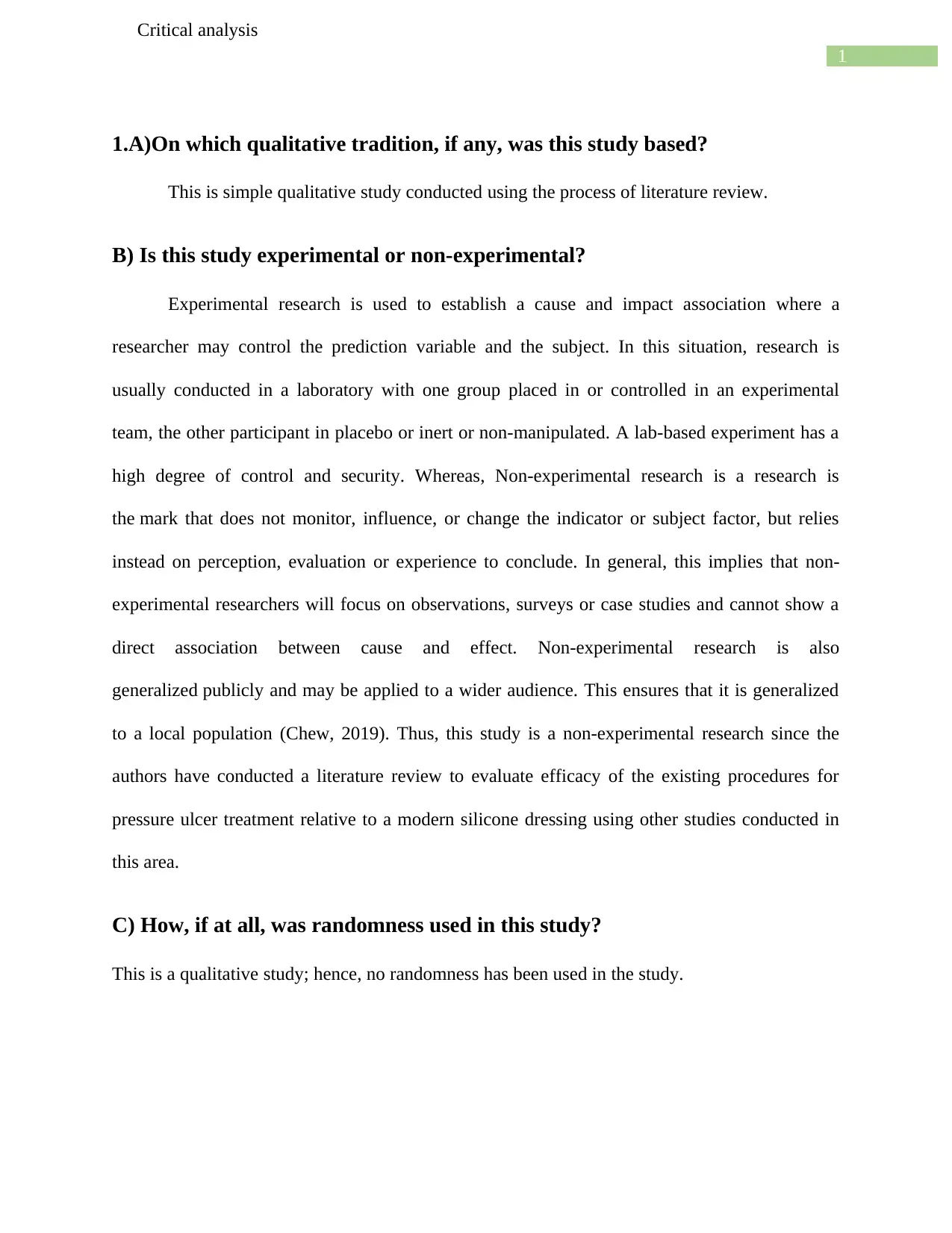
1
Critical analysis
1.A)On which qualitative tradition, if any, was this study based?
This is simple qualitative study conducted using the process of literature review.
B) Is this study experimental or non-experimental?
Experimental research is used to establish a cause and impact association where a
researcher may control the prediction variable and the subject. In this situation, research is
usually conducted in a laboratory with one group placed in or controlled in an experimental
team, the other participant in placebo or inert or non-manipulated. A lab-based experiment has a
high degree of control and security. Whereas, Non-experimental research is a research is
the mark that does not monitor, influence, or change the indicator or subject factor, but relies
instead on perception, evaluation or experience to conclude. In general, this implies that non-
experimental researchers will focus on observations, surveys or case studies and cannot show a
direct association between cause and effect. Non-experimental research is also
generalized publicly and may be applied to a wider audience. This ensures that it is generalized
to a local population (Chew, 2019). Thus, this study is a non-experimental research since the
authors have conducted a literature review to evaluate efficacy of the existing procedures for
pressure ulcer treatment relative to a modern silicone dressing using other studies conducted in
this area.
C) How, if at all, was randomness used in this study?
This is a qualitative study; hence, no randomness has been used in the study.
Critical analysis
1.A)On which qualitative tradition, if any, was this study based?
This is simple qualitative study conducted using the process of literature review.
B) Is this study experimental or non-experimental?
Experimental research is used to establish a cause and impact association where a
researcher may control the prediction variable and the subject. In this situation, research is
usually conducted in a laboratory with one group placed in or controlled in an experimental
team, the other participant in placebo or inert or non-manipulated. A lab-based experiment has a
high degree of control and security. Whereas, Non-experimental research is a research is
the mark that does not monitor, influence, or change the indicator or subject factor, but relies
instead on perception, evaluation or experience to conclude. In general, this implies that non-
experimental researchers will focus on observations, surveys or case studies and cannot show a
direct association between cause and effect. Non-experimental research is also
generalized publicly and may be applied to a wider audience. This ensures that it is generalized
to a local population (Chew, 2019). Thus, this study is a non-experimental research since the
authors have conducted a literature review to evaluate efficacy of the existing procedures for
pressure ulcer treatment relative to a modern silicone dressing using other studies conducted in
this area.
C) How, if at all, was randomness used in this study?
This is a qualitative study; hence, no randomness has been used in the study.
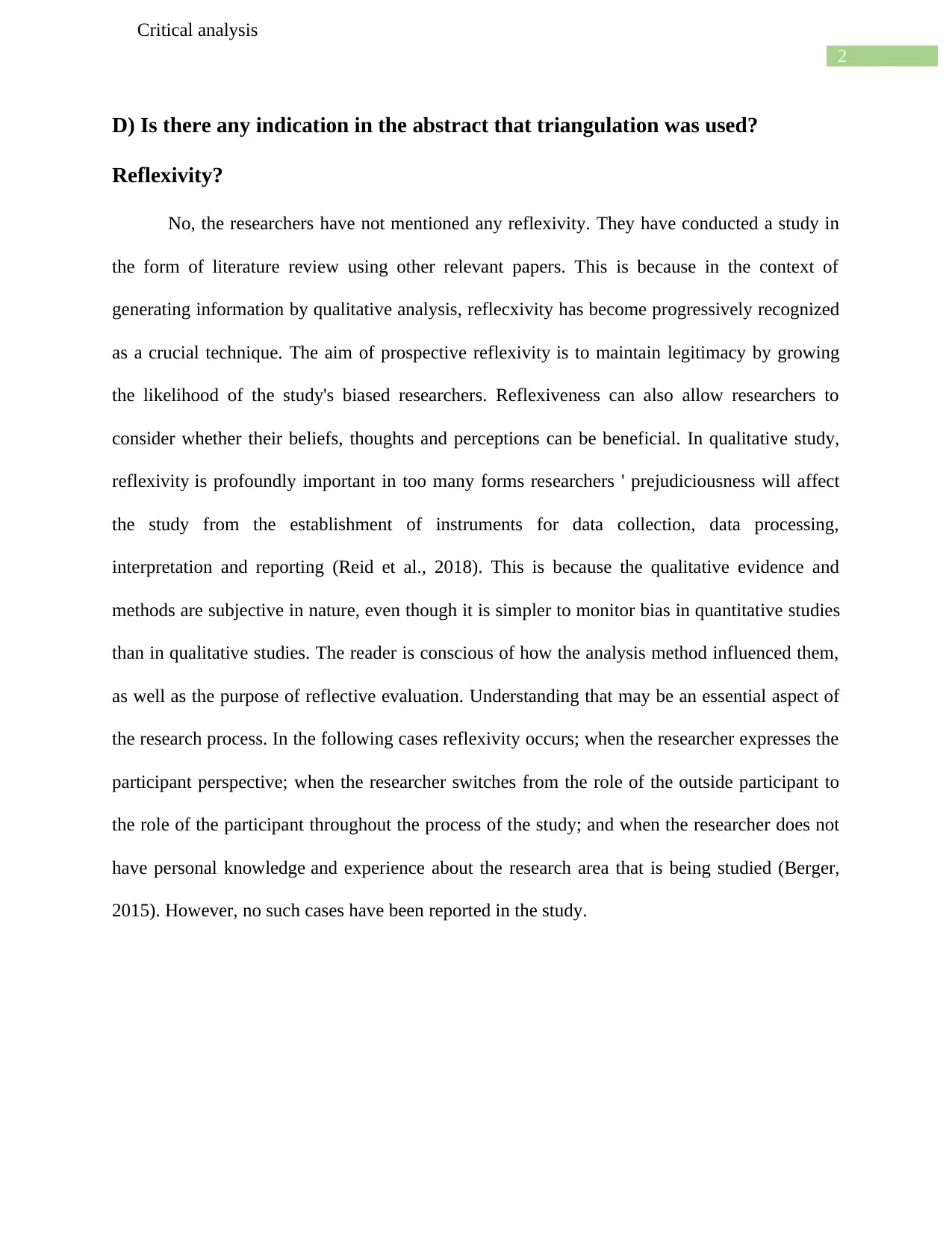
2
Critical analysis
D) Is there any indication in the abstract that triangulation was used?
Reflexivity?
No, the researchers have not mentioned any reflexivity. They have conducted a study in
the form of literature review using other relevant papers. This is because in the context of
generating information by qualitative analysis, reflecxivity has become progressively recognized
as a crucial technique. The aim of prospective reflexivity is to maintain legitimacy by growing
the likelihood of the study's biased researchers. Reflexiveness can also allow researchers to
consider whether their beliefs, thoughts and perceptions can be beneficial. In qualitative study,
reflexivity is profoundly important in too many forms researchers ' prejudiciousness will affect
the study from the establishment of instruments for data collection, data processing,
interpretation and reporting (Reid et al., 2018). This is because the qualitative evidence and
methods are subjective in nature, even though it is simpler to monitor bias in quantitative studies
than in qualitative studies. The reader is conscious of how the analysis method influenced them,
as well as the purpose of reflective evaluation. Understanding that may be an essential aspect of
the research process. In the following cases reflexivity occurs; when the researcher expresses the
participant perspective; when the researcher switches from the role of the outside participant to
the role of the participant throughout the process of the study; and when the researcher does not
have personal knowledge and experience about the research area that is being studied (Berger,
2015). However, no such cases have been reported in the study.
Critical analysis
D) Is there any indication in the abstract that triangulation was used?
Reflexivity?
No, the researchers have not mentioned any reflexivity. They have conducted a study in
the form of literature review using other relevant papers. This is because in the context of
generating information by qualitative analysis, reflecxivity has become progressively recognized
as a crucial technique. The aim of prospective reflexivity is to maintain legitimacy by growing
the likelihood of the study's biased researchers. Reflexiveness can also allow researchers to
consider whether their beliefs, thoughts and perceptions can be beneficial. In qualitative study,
reflexivity is profoundly important in too many forms researchers ' prejudiciousness will affect
the study from the establishment of instruments for data collection, data processing,
interpretation and reporting (Reid et al., 2018). This is because the qualitative evidence and
methods are subjective in nature, even though it is simpler to monitor bias in quantitative studies
than in qualitative studies. The reader is conscious of how the analysis method influenced them,
as well as the purpose of reflective evaluation. Understanding that may be an essential aspect of
the research process. In the following cases reflexivity occurs; when the researcher expresses the
participant perspective; when the researcher switches from the role of the outside participant to
the role of the participant throughout the process of the study; and when the researcher does not
have personal knowledge and experience about the research area that is being studied (Berger,
2015). However, no such cases have been reported in the study.
⊘ This is a preview!⊘
Do you want full access?
Subscribe today to unlock all pages.

Trusted by 1+ million students worldwide
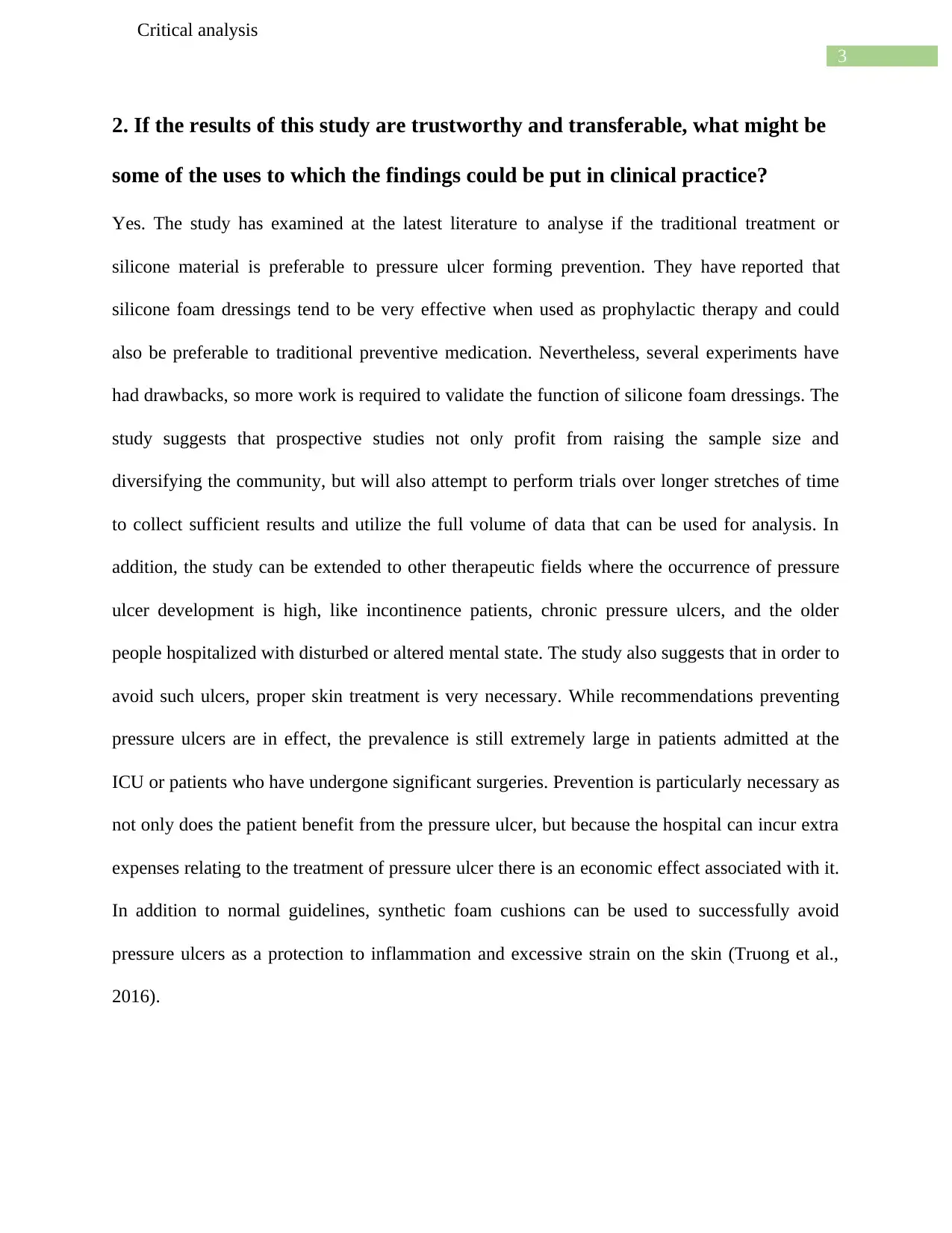
3
Critical analysis
2. If the results of this study are trustworthy and transferable, what might be
some of the uses to which the findings could be put in clinical practice?
Yes. The study has examined at the latest literature to analyse if the traditional treatment or
silicone material is preferable to pressure ulcer forming prevention. They have reported that
silicone foam dressings tend to be very effective when used as prophylactic therapy and could
also be preferable to traditional preventive medication. Nevertheless, several experiments have
had drawbacks, so more work is required to validate the function of silicone foam dressings. The
study suggests that prospective studies not only profit from raising the sample size and
diversifying the community, but will also attempt to perform trials over longer stretches of time
to collect sufficient results and utilize the full volume of data that can be used for analysis. In
addition, the study can be extended to other therapeutic fields where the occurrence of pressure
ulcer development is high, like incontinence patients, chronic pressure ulcers, and the older
people hospitalized with disturbed or altered mental state. The study also suggests that in order to
avoid such ulcers, proper skin treatment is very necessary. While recommendations preventing
pressure ulcers are in effect, the prevalence is still extremely large in patients admitted at the
ICU or patients who have undergone significant surgeries. Prevention is particularly necessary as
not only does the patient benefit from the pressure ulcer, but because the hospital can incur extra
expenses relating to the treatment of pressure ulcer there is an economic effect associated with it.
In addition to normal guidelines, synthetic foam cushions can be used to successfully avoid
pressure ulcers as a protection to inflammation and excessive strain on the skin (Truong et al.,
2016).
Critical analysis
2. If the results of this study are trustworthy and transferable, what might be
some of the uses to which the findings could be put in clinical practice?
Yes. The study has examined at the latest literature to analyse if the traditional treatment or
silicone material is preferable to pressure ulcer forming prevention. They have reported that
silicone foam dressings tend to be very effective when used as prophylactic therapy and could
also be preferable to traditional preventive medication. Nevertheless, several experiments have
had drawbacks, so more work is required to validate the function of silicone foam dressings. The
study suggests that prospective studies not only profit from raising the sample size and
diversifying the community, but will also attempt to perform trials over longer stretches of time
to collect sufficient results and utilize the full volume of data that can be used for analysis. In
addition, the study can be extended to other therapeutic fields where the occurrence of pressure
ulcer development is high, like incontinence patients, chronic pressure ulcers, and the older
people hospitalized with disturbed or altered mental state. The study also suggests that in order to
avoid such ulcers, proper skin treatment is very necessary. While recommendations preventing
pressure ulcers are in effect, the prevalence is still extremely large in patients admitted at the
ICU or patients who have undergone significant surgeries. Prevention is particularly necessary as
not only does the patient benefit from the pressure ulcer, but because the hospital can incur extra
expenses relating to the treatment of pressure ulcer there is an economic effect associated with it.
In addition to normal guidelines, synthetic foam cushions can be used to successfully avoid
pressure ulcers as a protection to inflammation and excessive strain on the skin (Truong et al.,
2016).
Paraphrase This Document
Need a fresh take? Get an instant paraphrase of this document with our AI Paraphraser
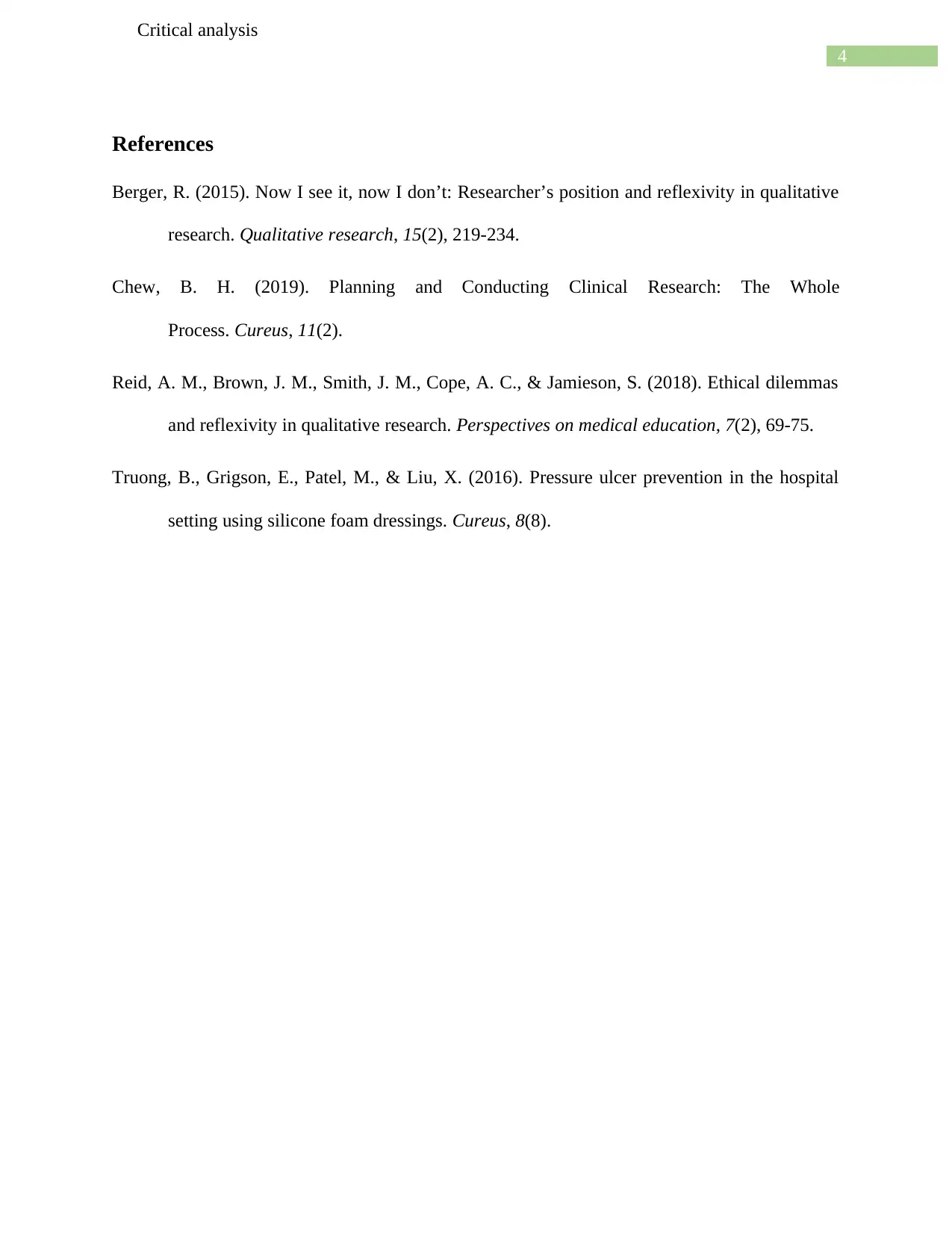
4
Critical analysis
References
Berger, R. (2015). Now I see it, now I don’t: Researcher’s position and reflexivity in qualitative
research. Qualitative research, 15(2), 219-234.
Chew, B. H. (2019). Planning and Conducting Clinical Research: The Whole
Process. Cureus, 11(2).
Reid, A. M., Brown, J. M., Smith, J. M., Cope, A. C., & Jamieson, S. (2018). Ethical dilemmas
and reflexivity in qualitative research. Perspectives on medical education, 7(2), 69-75.
Truong, B., Grigson, E., Patel, M., & Liu, X. (2016). Pressure ulcer prevention in the hospital
setting using silicone foam dressings. Cureus, 8(8).
Critical analysis
References
Berger, R. (2015). Now I see it, now I don’t: Researcher’s position and reflexivity in qualitative
research. Qualitative research, 15(2), 219-234.
Chew, B. H. (2019). Planning and Conducting Clinical Research: The Whole
Process. Cureus, 11(2).
Reid, A. M., Brown, J. M., Smith, J. M., Cope, A. C., & Jamieson, S. (2018). Ethical dilemmas
and reflexivity in qualitative research. Perspectives on medical education, 7(2), 69-75.
Truong, B., Grigson, E., Patel, M., & Liu, X. (2016). Pressure ulcer prevention in the hospital
setting using silicone foam dressings. Cureus, 8(8).
1 out of 5
Related Documents
Your All-in-One AI-Powered Toolkit for Academic Success.
+13062052269
info@desklib.com
Available 24*7 on WhatsApp / Email
![[object Object]](/_next/static/media/star-bottom.7253800d.svg)
Unlock your academic potential
Copyright © 2020–2025 A2Z Services. All Rights Reserved. Developed and managed by ZUCOL.



